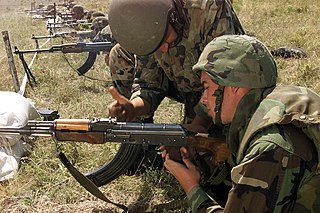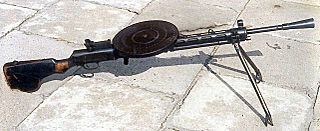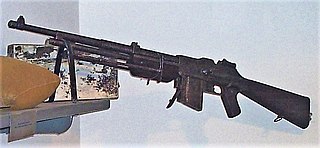
A squad automatic weapon (SAW), also known as a section automatic weapon or light support weapon (LSW), is a man-portable automatic firearm attached to infantry squads or sections as a source of rapid direct firepower. Weapons fulfilling this role can be light machine guns, or modified selective-fire rifles fitted with a heavier barrel, bipod and a belt/drum-fed design.

A light machine gun (LMG) is a light-weight machine gun designed to be operated by a single infantryman, with or without an assistant, as an infantry support weapon. LMGs firing cartridges of the same caliber as the other riflemen of the same combat unit are often referred to as squad automatic weapons.

The FN Minimi is a Belgian 5.56mm light machine gun, also classified as a squad automatic weapon developed by Ernest Vervier for FN Herstal. Introduced in the late 1970s, it is in service in more than 75 countries. The weapon is manufactured at the FN facility in Herstal and their U.S. subsidiary FN Manufacturing LLC.

The Degtyaryov machine gun or DP-27/DP-28 is a light machine gun firing the 7.62×54mmR cartridge that was primarily used by the Soviet Union, with service trials starting in 1927, followed by general deployment in 1928.

The Stoner 63 is a 5.56×45mm NATO modular weapon system. Using a variety of modular components, it can be configured as an assault rifle, carbine, top-fed light machine gun, belt-fed squad automatic weapon, or as a vehicle mounted weapon. Also known as the M63, XM22, XM23, XM207 or the Mk 23 Mod 0 machine gun, it was designed by Eugene Stoner in the early 1960s. Cadillac Gage was the primary manufacturer of the Stoner 63 during its history. The Stoner 63 saw very limited combat use by United States forces during the Vietnam War. A few were also sold to law enforcement agencies.

The Maschinengewehr 08, or MG 08, was the German Army's standard machine gun in World War I and is an adaptation of Hiram S. Maxim's original 1884 Maxim gun. It was produced in a number of variants during the war. The MG 08 served during World War II as a heavy machine gun in many German infantry divisions, although by the end of the war it had mostly been relegated to second-rate fortress units.

The Hotchkiss gun can refer to different products of the Hotchkiss arms company starting in the late 19th century. It usually refers to the 1.65-inch (42 mm) light mountain gun; there were also a navy (47 mm) and a 3-inch (76 mm) Hotchkiss guns. The 42 mm gun was intended to be mounted on a light carriage or packed on two mules to accompany a troop of cavalry or an army travelling in rough country.
The INSAS, or Indian Small Arms System, is a family of infantry arms consisting of an assault rifle and a light machine gun (LMG). These weapons were developed in India by the Armament Research and Development Establishment and manufactured by the Ordnance Factories Board at its various factories. It was the standard infantry weapon of the Indian Armed Forces for almost three decades.

The Browning wz.1928 is a Polish version of the M1918 Browning Automatic Rifle. It was used as a light machine gun by the Polish Military and Polish Resistance Forces during World War II.
The Hotchkiss M1909 machine gun was a light machine gun of the early 20th century that was developed and built by Hotchkiss et Cie. It was also known as the Hotchkiss Mark I, Hotchkiss Portative and M1909 Benét–Mercié.
The Colt Automatic Rifle or Colt Light Machine Gun is a 5.56 mm NATO, open-bolt, full-automatic-only firearm developed by Colt Defense. It is based on the M16A2/A4, and has a distinctive squared-off handguard, vertical grip, carrying handle and integrated bipod.
The Bergmann MG 15nA was a World War I light machine gun produced by Germany starting in 1915. It used 100- and 200-round belts and utilized a bipod, which allowed the weapon to be mounted on a flat surface for more accurate firing.

The Daewoo Precision Industries K3 is a South Korean light machine-gun. It is the third indigenous firearm developed in South Korea by the Agency for Defense Development, following the Daewoo Precision Industries K1 assault rifle and Daewoo Precision Industries K2 assault rifle. It is manufactured by Daewoo Precision Industries, current SNT Motiv. The K3 is capable of firing both 5.56×45mm NATO and .223 Remington rounds like the K2 assault rifle. The K3 light machine gun entered service in 1989, replacing the M60 machine gun in frontline use.

The Dror light machine gun was an Israeli light machine gun based on the M1941 Johnson light machine gun.

The Zastava M72 is a light machine gun developed and manufactured by then Yugoslav Zastava Arms company. The M72 was patterned after the Soviet RPK light machine gun.
The Knight's Armament Company Light Assault Machine Gun (LAMG) is a light machine gun system developed by Eugene Stoner and manufactured by Knight's Armament Company (KAC). It was previously known as the Knight's Armament Company LMG. It is the current evolution of the Stoner Light Machine Gun concept.
The Leichtes Maschinengewehr Modell 1925 is a Swiss recoil operated light machine gun designed by Colonel Adolf Furrer of Waffenfabrik Bern in the 1920s and produced from 1925 to the 1960s. It was the first machine gun in the Swiss Army that could be carried by a man. It takes the 7.5 mm Swiss Service cartridge from a 30-round box magazine and has a cyclic rate of fire of about 500 rounds-per-minute. In 1957, the LMG 25 was replaced by the Stgw 57-Assault rifle.
During the Second World War, the Canadian Army used the rifle section as its smallest organized formation of combat infantry soldiers. The organization was substantially similar to that of the Australian Army and the British Army with three sections to the platoon and three platoons to the rifle company.

The Bofors 25 mm M/32 was a Swedish- designed and built light anti-aircraft gun that was used aboard ships of the Swedish Navy during the Second World War.